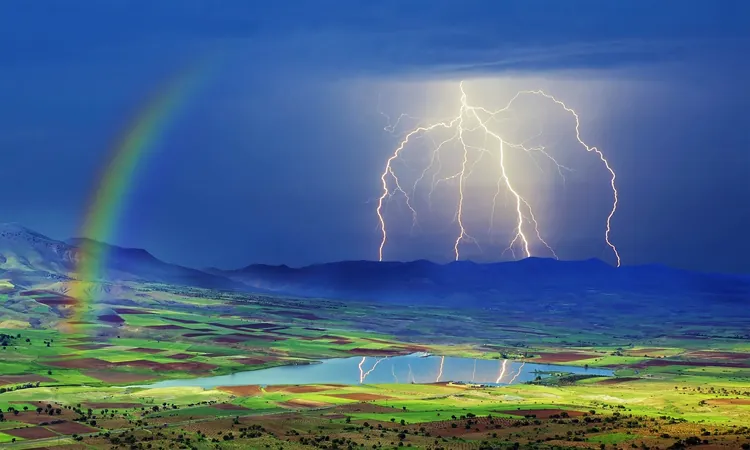
A Million Years of Rain: How the Carnian Pluvial Episode Set the Stage for Dinosaurs’ Dominance
2024-11-14
Author: Ken Lee
The Scientific Breakthrough
A team comprising Dr. Jacopo Dal Corso from the China University of Geosciences at Wuhan and Professor Mike Benton from the University of Bristol has made groundbreaking strides in understanding this pivotal moment in Earth's history. Their collaborative study reveals how the CPE not only altered terrestrial life but also profoundly impacted marine ecosystems.
Understanding the Carnian Pluvial Episode
During the Late Triassic period, all continents were connected in a supercontinent named Pangea, surrounded by the expansive Panthalassa Ocean. Initially, Pangea's interior was arid, with most rainfall occurring in coastal areas. However, geological evidence discovered in the Northern Limestone Alps of Austria in the 1970s pointed to moisture interrupting these dry spells, suggesting the onset of the Carnian Pluvial Episode.
The trigger for this climatic shift? Massive volcanic eruptions in the Wrangellia Province, which now encompasses parts of Alaska and British Columbia. According to Dr. Dal Corso, these eruptions released vast amounts of carbon dioxide into the atmosphere, leading to significant spikes in global temperatures.
The Consequences of Climate Change
The increase in greenhouse gases raised global temperatures by approximately 5 to 7 degrees Fahrenheit. This spike in warmth intensified evaporation from the oceans and correspondingly increased rainfall worldwide. This tumultuous climate led to extensive biodiversity loss, as numerous species were ill-equipped to adapt to the rapid environmental changes—a mass extinction event in its own right.
However, as some species vanished, new ones emerged, transforming ecosystems into forms more recognizable to us today. “The new floras probably provided slim pickings for the surviving herbivorous reptiles,” Professor Benton notes. Interestingly, while the first dinosaurs appeared around 20 million years prior, their significant rise in prominence only began after the humid conditions subsided.
The Rise of Dinosaurs and Other Creatures
With the shift back to drier conditions, dinosaurs began to flourish. This era also ushered in the earliest turtles, crocodiles, lizards, and even the first mammals. As conifer forests expanded, they created diverse habitats for these creatures, fostering innovation in life forms.
The event also transformed marine life, marking the emergence of modern coral reefs and various plankton species. This radical alteration in ocean chemistry affected the entire marine food chain, leading to a wave of new life beneath the waves.
Recognizing a New Mass Extinction
Historically, paleontologists have identified five significant mass extinctions over the past 500 million years. However, this research provides evidence for a sixth event—one that significantly shaped the trajectory of life both on land and in the sea. Dr. Dal Corso describes this event as a critical reset in Earth's ecosystems.
Learning from the Past: Insights into Climate Change
The lessons derived from the Carnian Pluvial Episode are especially pertinent in today's world. The findings highlight how massive volcanic eruptions can lead to rapid climatic shifts. As current human activities drive greenhouse gas levels ever higher, understanding the responses of ecosystems to such historical changes becomes crucial.
Dr. Dal Corso emphasizes the scale of the volcanic activity, stating, "The eruptions were so massive that they dramatically altered the planet’s climate." This historical account serves as a stark reminder of nature’s power and the interconnectedness of life on Earth.
Looking Forward
The Carnian Pluvial Episode illustrates not only Earth's remarkable ability to recover but also the adaptability of life in the face of change. As we confront modern environmental challenges, reflecting on past events provides essential insights that may guide our future responses to climate crises.
Scientific discoveries continue to paint a more nuanced picture of our planet’s history, revealing the resilience of life through millennia of dramatic shifts. Each finding reshapes our understanding and invites us to ponder how life on Earth will adapt in the ongoing saga of existence—an exploration marked by both vulnerability and endurance.
Stay tuned as we dive deeper into our planet’s history, exploring the pivotal moments that define life as we know it today.




 Brasil (PT)
Brasil (PT)
 Canada (EN)
Canada (EN)
 Chile (ES)
Chile (ES)
 España (ES)
España (ES)
 France (FR)
France (FR)
 Hong Kong (EN)
Hong Kong (EN)
 Italia (IT)
Italia (IT)
 日本 (JA)
日本 (JA)
 Magyarország (HU)
Magyarország (HU)
 Norge (NO)
Norge (NO)
 Polska (PL)
Polska (PL)
 Schweiz (DE)
Schweiz (DE)
 Singapore (EN)
Singapore (EN)
 Sverige (SV)
Sverige (SV)
 Suomi (FI)
Suomi (FI)
 Türkiye (TR)
Türkiye (TR)